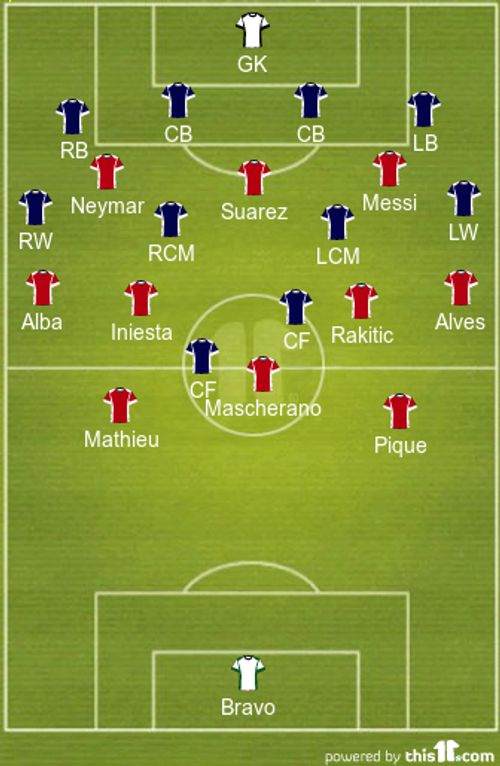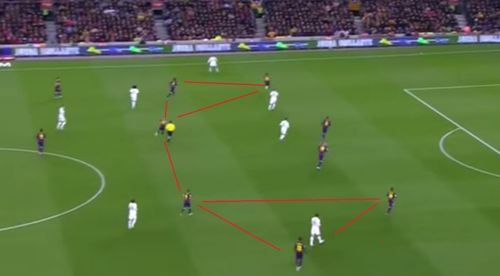
How Luis Enrique's new tactical set-up can help Barcelona rule Europe again

It wasn’t too long ago that Barcelona manager Luis Enrique was under fire, as more than a handful believed he wasn’t capable of producing the desired results nor was he equipped to form a winning combination. To top it off, he had a very shaky relationship with the club’s superstar Lionel Messi, to the extent that there were even rumours of the latter’s exit from his boyhood club.
At that point it seemed like turning out to be another disastrous season for the Blaugrana outfit. But to everyone’s surprise, in just a few weeks’ time, the tables have completely turned with Barcelona in complete control in all competitions. And while people had gone all guns blazing on Enrique when the team was underperforming, the manager has hardly been able to grab the spotlight for his contribution to the turnaround.
The Catalans have only been singing the praises of the holy trinity – Messi, Neymar and Suarez.
But there’s no denying that the Barcelona manager has tactically tweaked his side according to the situation, and it looks like he has finally begun to play his cards right. To face Manchester City and Real Madrid within a span of 100 hours and to come out successful on both occasions is quite an achievement, and Enrique has given us a clear picture of the tactical nous he possesses.
Let us have a look at a brief analysis of the changes he has effected, taking the 2-1 win over Real Madrid as an example:
Barcelona’s usual attacking shape

The usual tactics deployed by Enrique involve keeping the back four of the opposition under wraps, with Messi and Neymar drifting towards the centre and remaining close to Suarez who is at a typical number 9 position. Now there is a 3v4 situation with the forwards going at the back four directly. So when Alves and Alba charge forward to support the attack, it is up to the opposition wingers or the central midfielders to track them back.
Since the Barca full backs adopt a very high position, the opposition wingers are pushed quite deep into their own halves and this makes it difficult for them to counter-attack even when the ball is won back in their own half, as they would be short of options to break away on the counter. Thus when Barca lose the ball, they have all areas covered with enough options to press and win back possession. For instance, if the ball is lost on the right, the triangle of Neymar, Iniesta and Alba would deploy high pressing.
With the opposition wingers in their own half, the obvious options would be to counter with the two forwards (or one attacking midfielder and a forward). But with Mascherano, Pique and Mathieu it would again be a 3v2 for Barcelona. Enrique has thus been able to deal with the opposition’s counter attack quite efficiently ever since his men have adapted to this style.

Attacking shape vs Real Madrid

Against their arch rivals, this was how Barcelona were set up while they were on the attack. Here, Messi and Neymar remained out wide to provide width to the attack, while Rakitic and Iniesta occupied the central spaces in the final third. There was thus a major difference between what Enrique usually does and what he did against Ancelotti’s men.
While Messi and Neymar generally tend to drift towards the centre and remain close to Suarez, allowing the full backs to charge forward, Enrique seemed to be aware of the threat that Ronaldo and Bale could create on the counter and so he didn’t risk deploying the full backs high up the field.
Hence, the onus was on Messi and Neymar to stretch the Madrid defense while Rakitic and Iniesta would drop into the pockets of space in the centre. Messi and Rakitic would swap positions occasionally to maintain the shape, which would allow the Argentine to showcase his creativity.
Barcelona’s defensive shape

Another surprising adjustment made by Enrique was that after taking the lead, Barca did fight hard for possession. Instead, they let Los Blancos have the ball and sat back to focus on containing the build-up play by Madrid. This was very atypical of Barcelona, who don’t defend by sitting back and letting the opponents come at them; as we all know, their style of defense revolves around high pressing and winning the ball back as quickly as possible.
Barcelona maintained a flat 4-4-2, with Neymar tracking back to join the midfield trio of Rakitic, Mascherano and Iniesta. The Brazilian seems to have improved his work rate over the course of the season and he aided his side defensively. Positioning himself alongside the midfield trio, he won two out of the four tackles attempted. It was evident that the midfield four had their tasks clearly cut out, as any attack on the right with Carvajal, Bale and Modric were taken care of by Neymar, Alba and Iniesta.
Meanwhile, Real’s major attacking channel comprising of Marcelo, Isco and Ronaldo were to be taken care of by Alves, Rakitic and Mascherano on the right. Enrique seemingly made this adjustment based on what he learned in his previous El Clasico. Ancelotti’s men had then attacked predominantly through overloading on the wings, with Marcelo, Isco and Ronaldo leaving Alves and Xavi in a 3v2 situation and Suarez hardly tracking back.
Thus, a 4-4-2 defensive shape was more effective, with Rakitic moving out wide to provide cover for Alves and Mascherano supporting the two against the trickery of Marcelo, Isco and Ronaldo on the left.
Set-pieces
After 18 minutes from kick-off, Barcelona were in front thanks to a brilliant header by Jeremy Mathieu. The goal was special not only because it had put the Catalans ahead, but also because it was their 12th goal from a set-piece this season – Barca are now the third-highest side with goals from set pieces in the 2014-15 campaign. They are also amongst the sides to concede the fewest through set-pieces, with just two goals, and this is probably the most under-rated upgrade that Enrique has brought to the side. It is no secret that set-pieces have been a huge headache for the Catalans for quite a while now.
As far as the Clasico was concerned, there is no doubt that Barca’s aerial abilities were really put to the test as Enrique’s men had to defend as many as 10 corners. Given Madrid’s strength in the air with the likes of Ramos, Ronaldo and Pepe (who scored through a corner in the previous Clasico), it does seem like Barcelona did their homework on improving in this area.
Long passing

Another predominant feature which has been instilled into Barca’s game-play this season is that when the players know they can reach the goal within two or three passes, they go ahead and find the back of the net. Dani Alves’ pass to Suarez is a prime example of this; Barca cleverly trapped Madrid into shifting to a high line defense and sat deep right from the moment the second half kicked off, letting Madrid come at them.
Madrid picked up from where they left off at the end of first half and started dominating proceedings right away. They enjoyed possession of around 65% in the first 10 minutes of the second half and as Barca went deeper into their own half, Madrid, keen to maintain the pressure, adapted to a high line defense. This allowed Suarez to run into a huge amount of space behind their back four and the Uruguayan put up a neat finish after receiving the pass superbly well. That seemed to take Ancelotti by surprise; Madrid looked to be in the driver’s seat for a while, and a moment of brilliance had just taken the game away from them.
A point to be noted here is that this is not the first time that Barcelona have found success in this fashion. The Catalans have scored four Liga goals from long passes this season, which is as many as in the previous seven seasons combined. Now that’s an interesting fact and it gives us quite a picture as to where Enrique is taking his side.

Counter-attacking football
In the second half, Barcelona gave their arch-rivals a taste of their own medicine by staying deeper in their own half and breaking away on the counter with Messi, Suarez and Neymar. Having taken the lead early in the second half, Enrique slightly tweaked his side in order to play counter-attacking football with the South American trio, which meant that the midfield three would stay deeper just ahead of the back four while the three forwards were free to press Madrid in their own half and ensure that Ancelotti’s men weren’t given a lot of time for build-up play.
Real Madrid had the lion’s share of possession in the first half an hour of the second half – around 63% – and as the game progressed towards the last 15 minutes, two changes were made by Enrique which completely took away the momentum from Madrid.

Regaining control

Sergio Busquets and Xavi Hernandez’s introduction at the 76th and 80th minutes respectively worked in Barca’s favour as the plan clearly was to milk the ball around in the last 10 minutes and kill the game. The duo gained control of the game at the centre of the park as they completed 31 out of the 32 passes attempted, and the Catalans effortlessly slowed down the tempo of the game.
Barca turned around possession with 58% to their favour in the last 10 minutes and in all honesty, they could have scored another goal or two more had the attacking trio been more clinical.
Conclusion
Enrique certainly seems to be a thinker, and he hasn’t backed off from making tactically bold decisions on the big stages. His proactive approach to decision-making has been a major reason behind the Blaugranas’ success in the last couple of months, and it looks like all is well at the Camp Nou with a hale and healthy squad competing for all trophies in the ongoing campaign.
Can he do the unthinkable of leading the Catalan giants to another treble? Only time can answer that but the way his team have tactically shaped up, they don’t look like the Barca which could bow out to counter-attacks, set-pieces or physical overpowering. It wouldn’t be an overstatement to say that Barcelona have arguably become the most tactically astute side in Europe today.